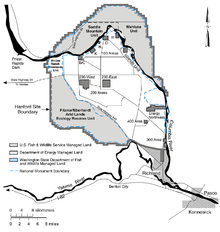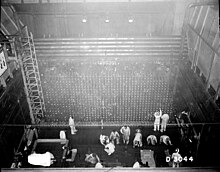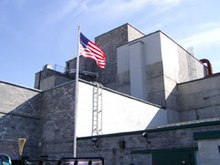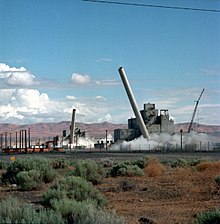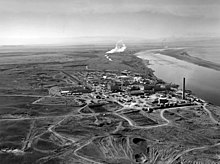Hanford Site
| ||
Some locations of the Manhattan Project |
The Hanford Site is a US nuclear complex on the Columbia River in southeast Washington state near the city of Richland . The area has a size of 1517 km², which is twice the area of Hamburg . Most of it is in Benton County . In 1943, construction of the plant began under the strictest secrecy as part of the Manhattan Project as " Hanford Engineer Works " or " Site W ". For this purpose, the federal government bought the cities of White Bluffs and Hanford and the surrounding farmland. All residents were relocated.
The main purpose of the Hanford Site during the Second World War and the Cold War was the production of plutonium for nuclear weapons . The plutonium produced in Hanford was used to build the first atomic bomb. This was detonated in the Trinity test area near Alamogordo in New Mexico . Furthermore, it was for the bomb Man Fat , on Nagasaki ( Japan was dropped) was used. Hanford is considered to be the most radioactively contaminated place in the Western Hemisphere. A total of 110,000 tons of nuclear fuel were produced here. After preparatory work, the largest decontamination campaign in the world has been carried out in Hanford since 2001 to safely dispose of the radioactive and toxic waste generated during the 50 years of plutonium production for American nuclear weapons.
Most of Hanford is in Benton County , but about 20 percent across the Columbia River is made up of Grant County and Franklin Counties . This land was part of the safety belt around the facility, is not contaminated and has already been cleared. It was sold to individuals and companies; meanwhile there are again irrigated fields and orchards. In 2000, further parts of the former safety belt were designated as the Hanford Reach National Monument nature reserve.
The contamination of the site could be detected in the local flora and fauna in 2010. Plants (e.g. trolleys ) and animals (e.g. mice or rabbits) absorb the contaminated material and distribute it across the site. Even terrain that has already been decontaminated has to be examined again and again for suspicious traces.
History of the Hanford Nuclear Plant
In July 1942, the Uranium Committee of the State Office of Scientific Research and Development (OSRD) started an intensive research program on plutonium at the University of Chicago Metallurgical Laboratory (MetLab). At the time, plutonium was a rare element that had only been isolated nine months earlier in a University of California laboratory .
Selection of Hanford
In June 1942, the Army Corps of Engineers established the Manhattan Engineer District (MED), better known as the Manhattan Project , to manufacture plutonium and uranium on an industrial scale for the MetLabs. In November 1942, DuPont signed a contract to build such a facility. DuPont recommended that plutonium production be located far away from uranium production in Oak Ridge National Laboratory , Tennessee .
The ideal location should meet the following requirements:
- a large, secluded piece of land
- a secured danger area of at least 19 km × 26 km
- Space for laboratories, at least 13 km away from the nearest reactor or the nearest enrichment facility
- no cities with more than 1000 inhabitants within a 32 km radius of the danger area
- no main roads, railway lines and workers' settlements closer than 16 km to the danger zone
- clean and reliable water supply
- enough electricity
- solid base for massive buildings
After an intensive search and pre-selection, General Leslie Groves , head of the Manhattan Project, had five locations to choose from. He chose Hanford in December 1942 as "ideal in all respects" (Matthias 1987) - with the exception of the villages of White Bluffs and Hanford. General Groves founded the Hanford Engineer Works in early February 1943. The federal government expropriated the land and relocated the population of the two places. Due to the food shortage during the war, prisoners were used to harvest the fields and orchards that were still tilled by the earlier residents.
The start of construction
Work on the Hanford Engineer Works (HEW) began in March 1943. Before the end of the war in August 1945, the HEW had erected 554 buildings:
- three reactors (100-B, 100-D, and 100-F)
- three 250 meter long plutonium processing plants (200-T, 200-B, and 200-U)
- 64 underground tanks for highly radioactive waste
- Uranium enrichment plants
- 621 km of road
- 254 km of railway line
- 4 electrical distribution stations
- plus hundreds of kilometers of fences
For this purpose, 600,000 m³ of concrete and 40,000 tons of steel were used at a total cost of 230 million US dollars.
In the city of Richland, shelters for workers were also built.
The reactor construction
In October 1943, DuPont began construction of the first reactor in Hanford, code-named B-Pile (Building 100-B). (Nuclear fission reactors were then commonly referred to as a pile .)
The construction was completed within a year. The first tests began on July 12, 1944. On September 13, 1944, the reactor was charged with slugs for the first time . These were cylinders about 2.5 cm in diameter and 7 cm in length made of metallic natural uranium with an aluminum shell. They were placed one behind the other in aluminum tubes that ran horizontally through the reactor core and through which cooling water flowed. Graphite served as the moderator .
The production of plutonium began on September 26, 1944, and after some difficulties, the first plutonium was produced on November 6, 1944. The plutonium was refined in Unit 221-T and brought to Los Alamos on February 5, 1945 . There, the bomb for the Trinity test and Fat Man, the bomb that was dropped on Nagasaki, were made from it.
After construction began on the first reactor, DuPont built two more identical reactors:
- 100-D began producing plutonium in December 1944
- 100-F in February 1945.
Each of the three reactors had a thermal output of 200 megawatts that was not used. Civilian electricity production through nuclear fission only began worldwide in the 1950s.
Production of plutonium
The manufacturing process of plutonium begins with the absorption of a neutron by a 238 U core. The resulting 239 U disintegrates with a half-life of 23.5 minutes through a β - decay to 239 Np , which, with a half-life of 3384 minutes (2.35 days) , disintegrates into 239 Pu through a further β - decay.
The irradiated slugs were first stored in water basins and then brought by train to one of the three separation plants 16 km away. There the plutonium was separated from the uranium and the remaining activation and fission products in a basin 260 m long, 20 m wide and 26 m deep and enriched in numerous purification stages. The first plant was called T-Plant and was completed in December 1944. Because of the radiation, the entire process had to be operated and monitored remotely. The reprocessing in T-Plant was stopped in 1956.
The Cold War
At the beginning of the Cold War in 1949, HEW built the H reactor with an output of 400 MW. In 1950 the 250 MW DR (D Replacement) reactor was put into operation. Also next to the B reactor was built: The C reactor with 600 MW thermal was put into operation in 1952. It soon became the main research reactor at Hanford. The C reactor was built for research and development. Just three months after its start, it was mainly used to test the double-K reactor (KE and KW, each with 1800 MW thermal output).
At the beginning of the 1960s, the five reactors from the 1940s had an output from 2015 to 2210 MW through numerous improvements, the C reactor 2500 MW and the K reactor 2 × 4400 MW.
The B reactor worked in the 1960s on the production of tritium for the hydrogen bombs, among other things. He was decommissioned on February 12, 1968. Since then, most of the facility has been dismantled and buried. The other reactors were shut down to allow their radioactivity to subside. The rest of the B reactor became a museum.
The reactors were built on the banks of the Columbia River because they needed its water for cooling. Huge pumping stations transported the water to the reactors and back again. Since these reactors worked without a secondary cooling circuit, the cooling water leaving the reactors was heavily contaminated with radioactive fission products. Although it was allowed to settle in huge basins for six hours before it was discharged into the Columbia River, several terabecquerels of long-lived nuclides found their way into the river and thus into the environment every day , leading to protests by the health departments of Oregon and Washington as well as around 1960 led the US Public Health Service .
The Hanford N reactor went critical on December 31, 1963 . Its main task was the production of plutonium, but it also produced electricity and was therefore the only reactor in the USA that was used for both military and civil purposes.
| Surname | start of building | Prod. Start | Shut down |
|---|---|---|---|
| B. | Jun 7, 1943 | 26 Sep 1944 | Feb 12, 1968 |
| D. | Nov 1943 | December 17, 1944 | Jun 26, 1967 |
| F. | Dec 1943 | Feb 25, 1945 | Jun 25, 1965 |
| DR | Dec 1947 | Oct 3, 1950 | Dec 31, 1964 |
| H | March 1948 | Oct. 29, 1949 | Apr 21, 1965 |
| C. | Jun. 1951 | Nov 18, 1952 | Apr 25, 1969 |
| KW | Nov 1952 | Jan. 1955 | Feb. 1, 1970 |
| KE | Jan. 1953 | April 1955 | Jan. 28, 1971 |
| N | May 1959 | Dec 31, 1963 | Oct. 1989 |
Fuel rod problems and accidents
Due to the increasing demand for plutonium, the reactors had increasing problems with the fuel rods. The shells of the fuel rods were made of aluminum, penetrating cooling water caused the uranium to swell and blocked the cooling flow. In some cases this even led to the melting of some parts in the fuel rod.
There was no incident during World War II, but in December 1945 a visual inspection found 125 damaged fuel rods.
In 1948 a radioactive cloud emerged from the facility. The iodine- 131 content alone was 5500 curie ; this corresponds to roughly 250 times the amount that, according to official figures, was released into the area in the 1979 accident at the Three Mile Island nuclear power plant near Harrisburg . The dangers of iodine-131 for the thyroid gland had not yet been recognized in the 1940s; it was able to escape unfiltered from the systems even during normal operation.
In the years that followed, damaged fuel rods were opened and examined underwater. To do this, they were brought to building 111-B and opened in steel tanks on a special lathe . After the radiometallurgy in Building 327 was over, fuel rods continued to be examined there.
In the 25 years of operation, many technical problems have been solved and numerous new machines and methods have been developed to increase the efficiency of the plant. The waste problem could not be solved, so that the waste was discharged into the Columbia River over the entire useful life.
Most of Hanford's reactors were shut down in the 1960s; however, no disposal or decontamination was carried out. In 2006, around 11,000 workers were still busy cleaning up contaminated buildings and floors in order to reduce the radiation intensity on the site to an acceptable level. These measures are estimated to last until 2052. The current plan is to bury low level radioactive waste in large pits and then carefully monitor it for many years.
Highly radioactive waste, including tanks of liquid waste from chemical plutonium extraction , is a bigger problem. For example, plutonium has a half-life of 24,100 years, so it takes about 241,000 years (24,100 years × log 2 1000) to decay 99.9% of the plutonium present . Mastering this problem is part of an ongoing debate. The US Department of Energy (DoE) plans glazing as a method of securing the substances.
Decontamination in Hanford
The plant will be partially dismantled . The US pays over two billion US dollars annually to private corporations for the necessary decontamination of the facility; In addition, around 200,000 cubic meters of radioactive waste must be disposed of. In early 2014, a decontamination project leader was dismissed for the third time after he or she raised concerns about the safety of the measures and monitoring procedures. A preliminary plan called for the end of the work in 2047, since 2014 the Ministry of Energy has been assuming at least 2052.
The clean-up campaign has the following goals:
- enable an alternative use of the area on the Columbia River,
- prepare the central plateau for processing and storing nuclear waste with a long half-life .

As the time of uranium enrichment and plutonium production in Hanford comes to an end, attempts are being made to find new jobs for the many highly qualified scientists and technicians. The Pacific Northwest National Laboratory , run by the federal government and the Battelle Memorial Institute , was built north of Richland .
Other facilities in Hanford include:
- the Fast Flux Test Facility (FFTF), shut down since 1992
- the LIGO of the Hanford Observatory and the Observatory in Livingston , Louisiana , an interferometer to search for gravitational waves
- the Columbia nuclear power plant , a commercial nuclear power plant for electricity production with 1200 MW electrical output; the boiling water reactor was built by General Electric from 1972 .
Whereabouts of the plutonium
It is relatively well known what happened to plutonium in the United States. The first 6 kg was used for the Trinity test in 1945 . The next 6 kg were detonated on August 9, 1945 in Fat Man, above Nagasaki .
Since then, a further 1200 tons of plutonium have been produced, approximately 260 tons of which is weapons grade plutonium.
On March 1, 1995, Bill Clinton ( US President from 1993 to 2001) announced that 200 tons would be removed from the supply. Of this, about 38 tons were weapons-grade material and 20 tons were "garbage". The US armed forces are said to have around 85 tons, 64 tons of which are used in nuclear weapons. The remaining 21 tons are stored in the form of solutions and nuclear waste in Rocky Flats and other facilities.
| Share 240 pu | Quality level |
|---|---|
| <7% | weapon capable 1 |
| 7-19% | Industrial quality |
| > 19% | reactor capable |
The Hanford Tank Farm
From the beginning, radioactive waste from chemical plutonium extraction has been a problem. Since it could not simply be discharged into the environment, it was filled into huge underground tanks. The tanks were filled one by one. In the period from 1943 to 1998, 177 tanks with a capacity of 250,000 to 4,546,000 liters were filled with liquid radioactive waste. Until recently, 241 million liters of radioactive chemical waste with a composition that varies from tank to tank and is often not precisely known has accumulated.
Of the 177 tanks, 149 are single-walled tanks from the period 1943 to 1964. After that, 28 double-walled tanks were built. The heat generated when the radioactive substances decay makes permanent cooling necessary. In addition, there is radiolytic hydrogen gas, which can not only build up considerable pressure, but is also radioactive due to the tritium ( 3 H) it contains. The solids suspended in the liquid waste collect through sedimentation , which leads to further problems such as heat build-up due to insufficient convection and difficult emptying of the tanks.
The tanks can be divided into four categories:
- Tanks with exothermic contents - they need to be cooled or water added
- Tanks with contents containing iron cyanide - the contents become explosive from a critical temperature
- Tanks with organic chemicals (mostly solvents) - easily flammable
- Tanks with hydrogen-producing contents - the resulting hydrogen contains radioactive tritium.
The service life envisaged during construction was 30 years for the single-walled tanks and 50 years for the double-walled tanks. The oldest tanks therefore already have twice their planned service life. According to estimates, 67 of the tanks have already leaked due to corrosion and embrittlement of the tank walls caused by radiation. In order to prevent further contamination of the surrounding soil, the contents of the single-walled tanks have been transferred to new double-walled tanks since 2003.
In 2008, the Department of Energy was heavily criticized in a report by the Government Accountability Office . Although it is estimated that more than four million liters of radioactive liquid have leaked from the containers, the clean-up work has been delayed. In 2010 you are already more than 20 years behind schedule.
In February 2013, it became known that six of the facility's underground tanks containing nuclear waste were leaking. These tanks with highly radioactive waste from decades of plutonium production for nuclear weapons are now older than the originally planned 20-year service life.
Interim storage facility in Hanford
In Hanford, the garbage is not only stored in the tank farm , but also in other places.
Since its closure in 1956, T-Plant has been used for decontamination work and also as a storage facility for a wide range of highly radioactive materials.
U-Plant (facility U-221) was originally used to recover uranium from the slag of the tank farm. Now contaminated equipment is stored there.
The K basins : After the K reactor was shut down (1970), two large basins (42 meters long, 22 meters wide and 7 meters deep) were available for the interim storage of spent fuel rods. In 1975 they began to store spent fuel rods from American nuclear power plants. There are currently approximately 2,100 tons of fuel rods in the basins, which is approximately 80% of all spent fuel rods in the United States.
Around 1000 tons of fuel elements are stored in the basin of the KE reactor, which is problematic because these fuel elements were not built for storage under water. As a result, many are damaged and sediment has accumulated at the bottom of the basin. In addition, the tank sealing is attacked, which led to a leak in February 1993, through which contaminated water could escape for several months.
The PUREX plant (S222) has been extracting plutonium and uranium from the spent uranium fuel rods in the Hanford reactors since January 12, 1956. In addition, 233 U was obtained from the thorium fuel rods of the N reactor. The facility was closed in 1993 and has served as a storage facility for a large part of the 200 tons of plutonium that President Clinton's orders removed from storage since 1995.
The Z Plant (Plutonium Finishing Plant) was operated from 1951 to 1989. There, the plutonium compounds from the PUREX process were processed into metallic plutonium. After production ended, around four tons of plutonium waste and countless other radioactive waste from production remained in the facility.
Hanford Reach National Monument
The former security strip with a width of 6 miles (approx. 10 km) around the site and the loop of the Columbia River were designated by President Bill Clinton as a nature reserve Hanford Reach National Monument and the US Fish and Wildlife Service in 2000 . The area currently covers almost 790 km² and is to be expanded to include decontaminated areas in the future. Around 80% of all king salmon of the upper Columbia River spawn in the river bend , the land areas have not been entered by people as a safety zone since 1943 and therefore have a wilderness character.
See also
- Mayak nuclear facility , Soviet bomb production facility
- Green Run , deliberate release of radiation on December 3, 1949
Movies
- The Hanford Ecology (1995)
- The Hanford Site Fire on the morning of June 29, 2000 (2000)
- Hanford's Secret Wartime Mission: 1943-1945 (2004)
- Arid Lands (2007)
- Nuclear Waste Nightmare (2009)
literature
- Michele Gerber: On the Home Front: The Cold War Legacy of the Hanford Nuclear Site . University of Nebraska Press, Lincoln 2007, ISBN 978-0-8032-5995-9 .
swell
-
Michael D'Antonio : Atomic Harvest: Hanford and the Lethal Toll of America's Nuclear Arsenal . Crown, New York 1993, ISBN 0-517-58981-8 .
- German translation by Thomas Jung: Bomb harvest. America's nuclear legacy . Aufbau-Verlag, Berlin 1994, ISBN 978-3-351-02423-9 .
- Gene Weisskopf: Historic American Engineering Record B Reactor (105-B Building) . HAER No. WA-164 (December 2000) This report has been scanned but is not yet online.
- Michele Gerber et al .: National Register of Historic Places Multiple Property Documentation Form - Historic, Archaeological and Traditional Cultural Properties of the Hanford Site, Washington . DOE / RL-97-02
- Chapter5: The Manhattan Project and Cold War Eras, Plutonium Production at the Hanford Site, Washington, December 1942-1990 " ( June 19, 2005 memento on the Internet Archive ) (February 1997)
Web links
- US Department of Energy: Hanford Site (Official Site )
- Overview at Globalsecurity.org
- Hanford Environmental Dose Reconstruction Project (HEDR)
- Independent Hanford website
- US nuclear plant Hanford Site: Plutonium for atomic bomb on Nagasaki , Deutschlandfunk Kultur, November 21, 2018
Individual evidence
- ↑ a b spiegel.de , February 23, 2013: US radiation ruins Hanford: Leaks in six underground nuclear waste tanks
- ^ The Wall Street Journal , December 23, 2010, Justin Scheck, online.wsj.com: Bunnies Are in Deep Doo-Doo When They 'Go Nuclear' at Hanford .
- ↑ a b c Rudolf Stumberger : At the river with the three-eyed fish - Friday, January 28, 2015
- ↑ Michele S. Gerber, Brian Casserly, Frederick L. Brown: National Historic Landmark Nomination: B Reactor / 105-B; The 105-B Building in the 100-B / C Area at Hanford ( October 26, 2012 memento in the Internet Archive )
- ↑ Marc Pitzke: US radiation ruins Hanford: America's atomic time bomb . In: Spiegel Online . March 22, 2011
- ↑ Los Angeles Times: Official who raised safety concerns at Hanford nuclear site is fired , Feb. 18, 2014
- ↑ GAO: More information needed on viability of Hanford tanks ( Memento October 11, 2008 in the Internet Archive ) (Annette Cary, July 1, 2008)
- ↑ New Scientist No. 2664 p. 7 "Toxic Time Bomb"
- ↑ NUCLEAR WASTE DOE Lacks Critical Information Needed to Assess Its Tank Management Strategy at Hanford (Original report , pdf, eng., June 2008; 2.1 MB)
- ↑ a b US radiation ruins Hanford: Leaks in six underground nuclear waste tanks. In: SPIEGEL ONLINE. SPIEGEL ONLINE GmbH, February 23, 2013, accessed on February 23, 2013 .
Coordinates: 46 ° 38 ′ 51 ″ N , 119 ° 35 ′ 55 ″ W.

